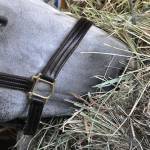Nutrients in Horse Forage: Questions Answered

Owners must rely on preserved forage for feeding horses during certain times of the year. When stored, hay loses some of its nutrient content, leaving horses in need of both energy and nutritional supplements.
Let’s find out what Kathleen Crandell, Ph.D., a nutritionist for Kentucky Equine Research, has to say about feeding horses low-quality hay and straw when fresh hay and pastures are unavailable.
How are nutrients in hay lost during storage?
Nutrients can be lost in different ways. Oxidation diminishes vitamins. Exposure to air and light after harvesting causes gradual deterioration of the vitamins, like vitamin A (in the form of carotenes) and vitamin E. Protein is also lost through denaturation during the baling process. Other protein losses can occur if the hay is excessively moist or if heating occurs within the bale. Heating can cause “caramelization” of proteins in the hay, further decreasing the total amount of available protein.
What vitamins and minerals are most commonly depleted from forage during storage?
The fat-soluble vitamins A and E are the most susceptible to loss during storage. Measurements have shown a loss of 75% of the carotenes (precursors to vitamin A) within 24 hours of cutting in the field and then a gradual loss of about 10% per month of the remaining carotenes. Hay stored for more than two years is essentially devoid of vitamin A. Vitamin E losses follow a similar pattern. On the other hand, since minerals are inorganic by nature, they are reasonably stable over time in conserved forage.
How does energy content differ between poor-quality hay and pasture or freshly baled hay?
The amount of energy in hay depends on the amount of sugar, digestible fiber (cellulose and hemicellulose), and indigestible fiber (e.g., lignin). Good-quality hay or fresh grass will be higher in sugars than poorer quality hay that was probably harvested at a later maturity. Mature hay has a lower amount of sugar because sugars were used for plant growth prior to harvesting. In sum, the more mature the plant at time of harvest, the lower the sugar and digestible fiber, the fractions that provide energy to horses, and the higher the indigestible components will be.
How does one assess forage quality to determine how much more energy a horse needs when fed poorer quality hay?
In some cases, simply looking at the hay can be an indication of its energy content. Hay that is mostly green and leafy with few stems or seed heads will generally be more digestible and therefore provide more energy than one that is stemmy with few leaves. The latter type of forage is mostly “gut fill” and provides “chew-time” for the horse.
When looking at mid-quality hays, it is not always easy to discern which are richest in energy. The most reliable way to know the caloric density of a hay is to have it analyzed.
The ultimate test of hay quality is consumption. If a horse eats the offered hay and maintains weight, then the energy content of the hay is sufficient. In contrast, if a horse loses weight, then supplementation of a concentrate feed for energy is important.
When can straw be offered to horses?
Feeding straw to horses is a centuries-old practice that continues today in some countries. The straw is chopped or chaffed for ease of use and in some cases mixed with molasses, oil, or a combination of both to control dust. For horses that are tremendously efficient in using calories derived from hay, feeding some straw in addition to hay may be an option. Straw can satisfy a horse’s need to chew without providing excess calories.
Straw is also an option if hay is not available, but feeding straw as the sole source of forage can be risky as the chance of colic may increase with the percentage of straw in the diet. If only straw is being offered, then a good-quality concentrate feed is highly recommended to provide calories as well as the protein, vitamins, and minerals that will be severely lacking in the straw. All effort should be made to find hay suitable for the energy requirement of the horse being fed.
Is straw palatable? If not, how can owners increase palatability to entice horses to eat straw when other forage options are unavailable?
Many horses do find clean, brightly-colored straw palatable. Oat, wheat, and barley straws are the most common types fed to horses. As many horse owners can attest, if a horse is hungry enough or has a need to chew, it will learn to eat straw. As mentioned before, chaff, commonly used in Europe, is often chopped straw mixed with molasses to improve palatability. In Australia, however, chaff is usually made from chopped hay.
What supplements should owners offer when poorer quality hay and straw make up the bulk of a horse’s diet?
Straw lacks all nutrients except indigestible fiber, so it is important to supply a source of essential nutrients. For the easy keeper, this could mean simply a low-intake ration balancer. Horses with higher energy demands may benefit from a concentrate feed that provides more calories along with the protein, vitamins, and minerals.








